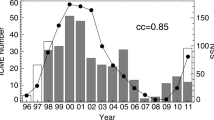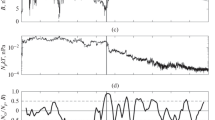Abstract
Based on the OMNI2 database for the period from 1976 to 2019, the behavior of the relative abundance of helium ions Nα/Np is investigated inside interplanetary coronal mass ejections (ICMEs). It is shown that the previously discovered anticorrelation between Nα/Np and the parameter β inside ICMEs is due to the dependence on magnetic pressure (or the magnitude of the interplanetary magnetic field), while the dependence of Nα/Np on the magnitude of the thermal pressure weakly falling in a magnetic cloud and increases in EJECTA. The data obtained are consistent with the previously suggested hypothesis that an electric current enriched with helium ions flows inside an ICME [1–3].


Similar content being viewed by others
REFERENCES
Yermolaev, Yu.I., Lodkina, I.G., Nikolaeva, N.S., et al., Dynamics of large-scale solar wind streams obtained by the double superposed epoch analysis, J. Geophys. Res., 2015, vol. 120, pp. 7094–7106. https://doi.org/10.1002/2015JA021274
Yermolaev, Yu.I., Estimation of the size of an electric current with high helium abundance inside a magnetic cloud, Cosmic Res., 2019, vol. 57, no. 6, pp. 471–472.
Yermolaev, Yu.I., Lodkina, I.G., Yermolaev, M.Yu., et al., Dynamics of large-scale solar-wind streams obtained by the double superposed epoch analysis: 4. Helium abundance, J. Geophys. Res., 2020, vol. 125, no. 7, id. e2020JA027878. https://doi.org/10.1029/2020JA027878
Zurbuchen, T.H. and Richardson, I.G., In-situ solar wind and magnetic field signatures of interplanetary coronal mass ejections, Space Sci. Rev., 2006, vol. 123, pp. 31–43. https://doi.org/10.1007/s11214-006-9010-4
Wu, C.-C. and Lepping, R.P., Comparisons of characteristics of magnetic clouds and cloud-like structures during 1995–2012, Sol. Phys., 2015, vol. 290, pp. 1243–1269. https://doi.org/10.1007/s11207-015-0656-5
Jian, L.K., Russell, C.T., Luhmann, J.G., et al., Properties of interplanetary coronal mass ejections at one AU during 1995–2004, Sol. Phys., 2006, vol. 239, pp. 393–436.
Yermolaev, Yu.I., Lodkina, I.G., Nikolaeva, N.S., et al., Dynamics of large-scale solar-wind streams obtained by the double superposed epoch analysis: 2. Comparisons of CIRs vs. SHEATHs and MCs vs. EJECTA, Sol. Phys., 2017, vol. 292, p. 193.
Yermolaev, Yu.I., Where are medium-scale solar-wind variations formed?, Geomagn. Aeron. (Engl. Transl.), 2014, vol. 54, no. 2, pp. 162–163.
Zelenyi, L.M. and Milovanov, A.V., Fractal topology and strange kinetics: from percolation theory to problems in cosmic electrodynamics, Phys.-Usp., 2004, vol. 47, no. 8, pp. 749–788.
Geiss, J., Processes affecting abundances in the solar wind, Space Sci. Rev., 1982, vol. 33, p. 201.
Ermolaev, Yu.I., Observation of He++ ions in the solar wind, Cosmic Res., 1994, vol. 32, no. 1, p. 71.
Geiss, J., Gloeckler, G., and Von Steiger, R., Origin of the solar wind from composition data, Space Sci. Rev., 1995, vol. 72, nos. 1–2, pp. 49–60.
Zurbuchen, T.H., Weberg, M., Von Steiger, R., et al., Composition of coronal mass ejections, Astrophys. J., 2016, vol. 826, no. 1, p. 10. https://doi.org/10.3847/0004-637X/826/1/10
King, J.H. and Papitashvili, N.E., Solar wind spatial scales in and comparisons of hourly wind and ace plasma and magnetic field data, J. Geophys. Res., 2004, vol. 110, no. A2, p. A02209.
Yermolaev, Yu.I., Nikolaeva, N.S., Lodkina, I.G., et al., Catalog of large-scale solar wind phenomena during 1976–2000, Cosmic Res., 2009, vol. 47, no. 2, pp. 81–94.
Bendat, J.S. and Piersol, A.G., Measurement and Analysis of Random Data, New York: Wiley-Interscience, 1971.
Wang, Y.-M., Relating the solar wind helium abundance to the coronal magnetic field, Astrophys. J., 2008, vol. 683, pp. 499–509. https://doi.org/10.1086/589766
Wang, Y.-M., Role of the coronal Alfvén speed in modulating the solar-wind helium abundance, Astrophys. J. Lett., 2016, vol. 833, id. L21. https://doi.org/10.3847/2041-8213/833/2/L21
ACKNOWLEDGMENTS
The authors are grateful to the developers of the OMNI database (http://omniweb.gsfc.nasa.gov) for the opportunity to use it in the study.
Author information
Authors and Affiliations
Corresponding author
Ethics declarations
The authors declare that they have no conflicts of interest.
Rights and permissions
About this article
Cite this article
Khokhlachev, A.A., Yermolaev, Y.I., Lodkina, I.G. et al. Helium Abundance Variations in Interplanetary Coronal Mass Ejections. Cosmic Res 60, 67–72 (2022). https://doi.org/10.1134/S0010952522020046
Received:
Revised:
Accepted:
Published:
Issue Date:
DOI: https://doi.org/10.1134/S0010952522020046




